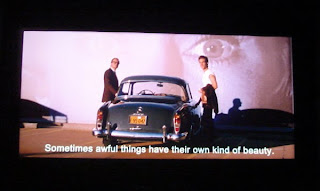I believe him. Is that why there are so many obvious errors?
Now a period film is exquisitely hard to make, and one will never have every detail correct, so pay attention to the important ones. For example, if a film is clearly set in November 1962 and the entire plot pivots around a terrible traffic accident in the late winter of 1962, approximately March, do not choose a 1963 Rambler Cross Country as the victim's mode of transport, as its unavailability at that time ruins the credibility of the production design. Are we to believe that the factory flew in a prototype for the express purpose of dispatching the late lamented lover?
Furthermore, the fact that the car lies totally undamaged on its roof as if gingerly placed there by an army of fairies is odd, and one wonders whether this was an attempt to sanitize the gruesome nature of an early sixties auto crash, or whether they simply had to have the Rambler back to Hollywood Picture Cars by 5 pm to avoid additional rental charges. However rationalized, the Rambler is an epic failure.
So the camera follows George (Colin Firth) to work in the morning, starting with an establishing shot of his oh-so-chic Mercedes 220S coupe in the carport. The camera pulls back slightly and reveals a yellow and black California 1956 license plate with a year sticker. Period correct. For a pickup truck. E 95 047. A Commercial plate. A passenger car would have a three letter, three number configuration such as ABC 123. A twelve year old could catch this one- so how did it work its way into this film so highly praised for detail? Or do glaringly inaccurate details still qualify?

The offending Mercedes, from the HDNB Blog.
I'll cruise past the conceivable but unlikely narrow whitewalls on the 220S and drive to school with George. We pull into his College parking lot and there in full glorious view for several seconds is the totally restyled 1966 Lincoln Continental convertible. Not the original 1961-63, not the lengthened second generation 1964-65 with totally new roofline, but the all new 1966. They're two generations off. I am now totally screaming inside, I can't think any more, and we're only twenty minutes into the film. Yes, I am a stickler for detail, but how can one make so many glaring mistakes in important scenes?
Oh, right. The quote. Tom said he didn't care about the details. Well, Tom, maybe if you ever make another film, and I'm certainly not suggesting that you do, you might think about caring. For all us little people in the dark.




I, too, love period-correct details done right — but I do think you're being a little harsh on the guy and/or his production designers. Their goal is to create a correct setting, of course, but more importantly a mood of the time, which I think they've done masterfully. And, for a director's first film to get Golden Globe nominations and Oscar buzz, I'd say he did focus a bit more on the story and a little less on the details – and we're left with a great little film about love and life because of it. But I promise I'm with you on your obsession: The college buildings used in the film didn't open until 1968.)
ReplyDeleteMy point is, focus enough on the details to get the major shots correct. The film didn't have to be set in November 1962, but he made it so with the Cuban Missile Crisis. So change the license plates to black ones and set it sometime in 1963, leave the '66 convertible off camera and we have excellent detail. And it wouldn't have changed the story one iota. I just hate important, wrong details.
ReplyDeleteAll good points. And in fact, it actually bugged me that the Mercedes had dry and cracked rubber around the windshield moldings, which it wouldn't have had if it were only a couple of years old by 1962, and that the leather on the back seat looked too aged (ditto). Told you I was obsessed. But in general, this movie came darn close to period correctness. I usually notice street signs or stoplights that are too new for the supposed time, or storefronts that may not have existed at the time — and I can't think of one obvious flub along those lines in "A Single Man." Great — now I have to go see it a FIFTH time.
ReplyDeleteMmmm ... Mercedes.
ReplyDeleteI preferred the 1960 Cadillac in Charlotte's driveway. Fins baby!
ReplyDelete